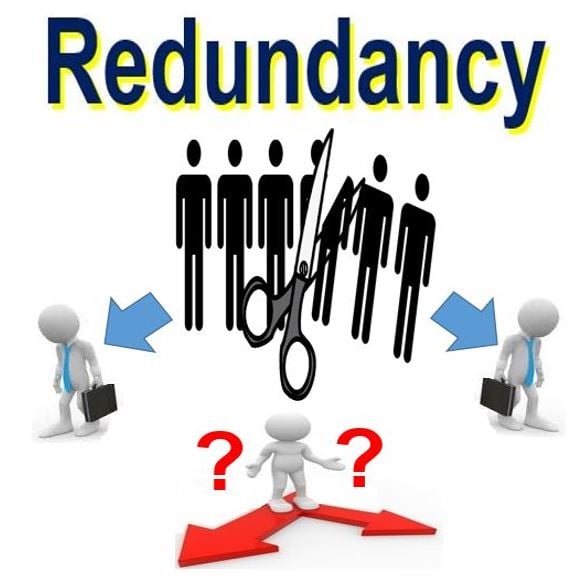Who Pays Redundancy Money? An In-depth Overview for Companies and Employees
Who Pays Redundancy Money? An In-depth Overview for Companies and Employees
Blog Article
Exploring the Operational Dynamics of Firm Redundancy and Its Long-Term Sustainability

Redundancy Strategies for Company Connection
In order to make sure continuous operations, businesses need to implement efficient redundancy approaches for organization connection. Redundancy in this context describes the replication of vital elements or features within a system to reduce the effect of prospective failings. By including redundancy methods, organizations can improve their durability against disturbances triggered by various elements such as all-natural disasters, tools failings, or cyber-attacks.
One usual redundancy method is the execution of backup systems and information storage space remedies. This includes producing matches of important data and systems that can be turned on in instance of a key system failing. In addition, companies can develop repetitive interaction networks and source of power to keep connection and procedures throughout unexpected occasions.
Furthermore, cross-training workers to execute several functions within the firm can work as a valuable redundancy strategy. If crucial employees are not available due to disease or various other factors, this makes sure that necessary tasks can still be lugged out even. On the whole, effective redundancy approaches are important for companies to support functional continuity and minimize the effect of potential disruptions.
Impact of Redundancy on Business Resilience
Offered the crucial duty redundancy techniques play in making sure business connection, discovering the influence of redundancy on organizational strength ends up being essential for understanding the holistic functional characteristics of a business. Organizational durability refers to an entity's ability to adapt to disturbances, recoup from troubles, and change when essential while keeping core functions. Redundancy, when purposefully implemented, can substantially add to enhancing a company's strength when faced with unforeseen challenges. By having backup systems, workers, or procedures in position, business can much better withstand shocks and proceed operations with very little disturbance.
Furthermore, redundancy can strengthen worker spirits and self-confidence, understanding that there are backup strategies in area to attend to unforeseen situations. This complacency can bring about boosted efficiency and a much more positive workplace. Furthermore, redundancy can cultivate advancement and creativity within a company as workers really feel empowered to take calculated threats, recognizing that there is a safety and security net to sustain them in case of failing. On the whole, the influence of redundancy on organizational strength is extensive, shaping the lasting sustainability and success of a firm.
Balancing Performance and Flexibility in Redundancy
Achieving an unified stability between operational effectiveness and flexible flexibility check my source is a pivotal challenge in the critical implementation of redundancy within companies. Also much adaptability without a strong functional foundation can result in ineffectiveness and variance.
To stabilize performance and flexibility in redundancy preparation, companies need to thoroughly analyze their operational demands, market characteristics, and strategic goals. Ultimately, locating the appropriate balance in between performance and adaptability is vital for building a resistant and lasting organization in the that site face of uncertainty.
Long-Term Sustainability Via Redundancy Planning
To make sure long-lasting feasibility and security, organizations have to tactically straighten their redundancy planning with lasting sustainability goals, thus balancing functional efficiency with flexible adaptability. Long-term sustainability via redundancy planning involves even more than just short-term cost-cutting procedures. It requires a thorough strategic strategy that anticipates future obstacles and chances. Companies must watch redundancy not as a reactive remedy to prompt issues yet as a proactive method for lasting success. By incorporating redundancy planning with sustainability purposes, companies can produce a durable structure that can hold up against numerous market changes and interior changes.

Proactive Steps for Sustainable Company Procedures
How can companies proactively improve their functional sustainability for long-term success? Implementing positive procedures is crucial for companies More about the author aiming to ensure lasting procedures. One crucial approach is to purchase technology and advancement to enhance procedures, minimize waste, and remain affordable in the market. Taking on sustainable practices such as decreasing energy intake, decreasing carbon impact, and enhancing source application can not only profit the setting however likewise lead to set you back financial savings in the future.
Additionally, promoting a culture of constant renovation and knowing within the organization can improve flexibility to altering market conditions and customer demands. Encouraging worker participation in decision-making procedures and providing possibilities for expert advancement can enhance morale, performance, and total efficiency. Developing clear goals, checking vital performance indicators, and frequently assessing development are crucial parts of positive sustainability management.
Working together with suppliers, clients, and other stakeholders to promote lasting practices throughout the supply chain can create a ripple result of favorable effect - redundancy pay if company goes bust. By taking positive steps towards operational sustainability, business can construct strength, drive advancement, and secure their lasting success in an ever-evolving company landscape
Verdict

In the realm of business monitoring, the tactical release of firm redundancy stands as a critical yet elaborate method that demands a delicate balance in between functional effectiveness and long-term feasibility. By studying the functional characteristics that underpin company redundancy and assessing its more comprehensive implications for organizational strength and flexibility, a nuanced understanding of how redundancy strategies can shape the future trajectory of a company begins to unravel.Given the vital function redundancy techniques play in guaranteeing organization connection, checking out the influence of redundancy on organizational durability ends up being important for recognizing the holistic operational dynamics of a company. On the whole, the effect of redundancy on business strength is profound, shaping the long-lasting sustainability and success of a business.
In verdict, understanding the operational dynamics of company redundancy is important for ensuring long-lasting sustainability.
Report this page